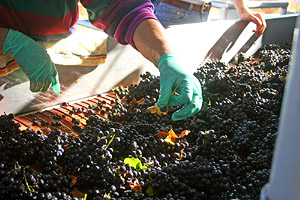 Here’s a question from one our customers about a grape destemmer that is listed on our website:
Here’s a question from one our customers about a grape destemmer that is listed on our website:
We want to keep grape hulls and juice together for fermentation, does this grape destemmer allow the hulls to pass through and not the stems?
This is a great questions! Particularly when you are making red wine, you want to keep the grape juice and the pulp together during the first few days of fermentation. This is how a wine develops a significant portion of it’s body and color.
To answer your question, yes, the grape destemmer you are referring to does allow all the pulp to pass through it. Only the stems are taken away, nothing else.
Once a cluster of grapes goes past the rollers and are crushed, they then fall into a cradle that has fast rotating paddles which beat the stems. This knocks all the skin and pulp loose.
The stems get slowly pushed out to the side of the grape destemmer by the beating paddles. Everything else: the pulp, the juice, the skins go out the bottom of the cradle through a series holes, then out the bottom of the destemmer to be collected by a fermenter or bucket of some sort.
You may want to take a look at the destemmer he is referring to: item number FP170, Marchisio Crusher & Destemmer listed on our website.
———————————————————————————————————
Ed Kraus is a 3rd generation home brewer/winemaker and has been an owner of E. C. Kraus since 1999. He has been helping individuals make better wine and beer for over 25 years.
Category Archives: Q&A
Is A Grape Press Needed To Making Wine At Home?
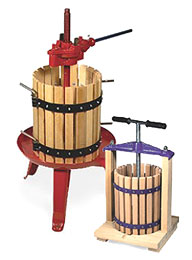 Let me dispel a wine making myth: You do not need a wine press to make wine. You can make perfectly good wine without getting any grape presses involved.
Let me dispel a wine making myth: You do not need a wine press to make wine. You can make perfectly good wine without getting any grape presses involved.
The purpose of having a wine press is a matter of efficiency, not necessity. Grape presses allow you to get more juice from the pulp then you would by just squeezing with your hands or something similar. They do not help you to make a better wine.
For example, in the case of a winery, using grape presses make perfect sense when considering the volume of pulp they are dealing with, a no-brainer. A wine press will pay for itself in the time it saves and the extra juice that is obtained. But for an individual making 5 gallons of wine a year, it’s more likely to not be practical. Better off to lose a little juice than pay for a press.
On the other hand if you’re making 20 or 30 gallons of wine a year, then you might want to start thinking about getting a wine press. Not only do grape presses help you to extract more juice from the pulp, but they can also save you time.
Another thing to consider are the types of wines you’ll want to make. If you think you will be making something other than grape wine such as elderberry, raspberry or even peach wine, the amount of fruit involved is not so great, usually around 15 pounds for a 5 gallon batch.
But if your making wine from wine grapes, then the amount of fruit involved is substantial, typically around 80 pounds of grapes to make 5 gallons. So the types of wines you’ll be making plays into your decision on whether you should go shopping for grape presses or not.
———————————————————————————————————
Ed Kraus is a 3rd generation home brewer/winemaker and has been an owner of E. C. Kraus since 1999. He has been helping individuals make better wine and beer for over 25 years.
What Should I Make My Wine In?
Hello Adventures in Homebrewing,
This year I will have blackberries and I want to get some wine brewing with them. I plan on getting some wine making products from you. Can you tell me what I should be making the wine in. Some say a stone crock others tell me to use a water jug. Can you help?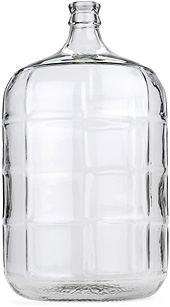
Denise G.
Clinton, MO_____
Dear Denise,
Thanks for the excellent question. Knowing where to start can be confusing, especially when you have so many people telling you so many things.
To have the easiest set-up you will need two different containers, one for the first five or six days of fermentation (primary fermentation), and the other for the rest of the fermentation (secondary fermentation).
You want the primary fermentation to be opened or exposed. A stone crock will work for this purpose, but is not necessary. A plastic fermenter bucket will work just as well. Cover the container with a thin towel or cloth during the fermentation.
The second part of the fermentation will need to be closed off from air. Most people will use carboys for this purpose, which is similar to a water jug. This type of container allows you to attach an air lock to it with a rubber stopper. This will cut off the air from the fermentation but still allow the gasses from the fermentation to escape.
I hope this helps you out.
Ed Kraus
———————————————————————————————————
Ed Kraus is a 3rd generation home brewer/winemaker and has been an owner of E. C. Kraus since 1999. He has been helping individuals make better wine and beer for over 25 years.
How Do I Know When My Steam Juicer Is Done Extracting Juice?
When using a steam juicer to extract the juice from grapes, how do you know when it’s done? In other words, how can you tell when the juicer has done all it can do?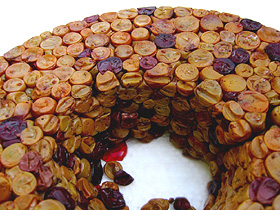
This is the question that was posed to us earlier today by one of our customers in Urbana, Illinois. They are going to make to make some homemade grape wine from Catawbas this year. What a great question!
The steam juicer we offer has a see-through lid. The reason for this is so you can see the condition of the fruit as it is being steam. Through this visual inspection you can tell if the fruit has any more to give or if it has been spent.
In the case of using the steam juicer for processing grapes, you will be able to see that what were once plump grapes are now slowly becoming smaller, shriveled grapes. Eventually, all the grapes will pack to the bottom and form a flat layer of skins. This layer will only be two or three inches high depending on the volume of your steam juicer.
The story is similar for other kinds of fruits as will when using a steam juicer. They will slowly lose their size and compact together at the bottom. Once this occurs, any further steaming is just a waste of time.
———————————————————————————————————
Ed Kraus is a 3rd generation home brewer/winemaker and has been an owner of E. C. Kraus since 1999. He has been helping individuals make better wine and beer for over 25 years.
Why Don't You Sell Rubber Stoppers And Air Locks Together?
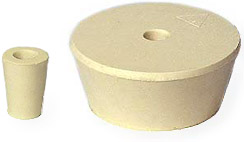 We are often asked why we don’t sell a rubber stopper along together with our air locks, bundled together so to speak. I mean what good is an air lock without the rubber stopper to fit it to something? Well, the answer is really pretty simple.
We are often asked why we don’t sell a rubber stopper along together with our air locks, bundled together so to speak. I mean what good is an air lock without the rubber stopper to fit it to something? Well, the answer is really pretty simple.
Rubber stoppers come in all different diameters–from the size of a dime on up to the size of a orange. The size of rubber stopper you need depends on the what you are trying to attach the air-lock to. For this reason alone we will never be able to sell a rubber stopper and air lock together.
Glass wine carboys have a different sized opening than a gallon glass jugs for example. One takes a size #7 rubber stopper while the other one takes a #8. If you’re using a plastic fermenter you may only need a size #2 rubber stopper. It just depends on the size of the opening.
You may want to take a look at another blog post that covers what rubber stopper fits what. You can also visit our website for more information about the rubber stoppers we have to offer.
———————————————————————————————————
Ed Kraus is a 3rd generation home brewer/winemaker and has been an owner of E. C. Kraus since 1999. He has been helping individuals make better wine and beer for over 25 years.
What's In A Wine Ingredient Kit?
Wine ingredient kits offers a great way to make wine when grapes are not in season. These kits contain all the ingredients you will need to produce a batch of wine, as long as you already have the equipment. But what is exactly in one of these kits?
The first thing you should know is that the grapes used to produce these kits are not just any grape from any vineyard down the road. These homemade wine kits contain grape juices collected from notable vineyard regions around the world: France, Italy, South Africa, Australia, New Zealand and, yes, California to name a few.
These kits also come with the wine yeast, fining agents, oak chips (if needed) and in most cases wine bottle labels–customized with the type of wine, alcohol percent, etc. The wine yeast is what does all the fermenting; the fining agents helps to clear the wine; and the oak chips give the wine a natural, barrel-aged flavor.
Another big advantage to making wine with these ingredient kits is that they come with directions that are specific to what you have in front of you. No guessing. The homemade wine instructions make life easy.
So take a look at the ingredient kits that we offer. There are over 200 to choose from: red, white, sweet, dry. There’s one to suite everyone’s taste.
———————————————————————————————————
Ed Kraus is a 3rd generation home brewer/winemaker and has been an owner of E. C. Kraus since 1999. He has been helping individuals make better wine and beer for over 25 years.
